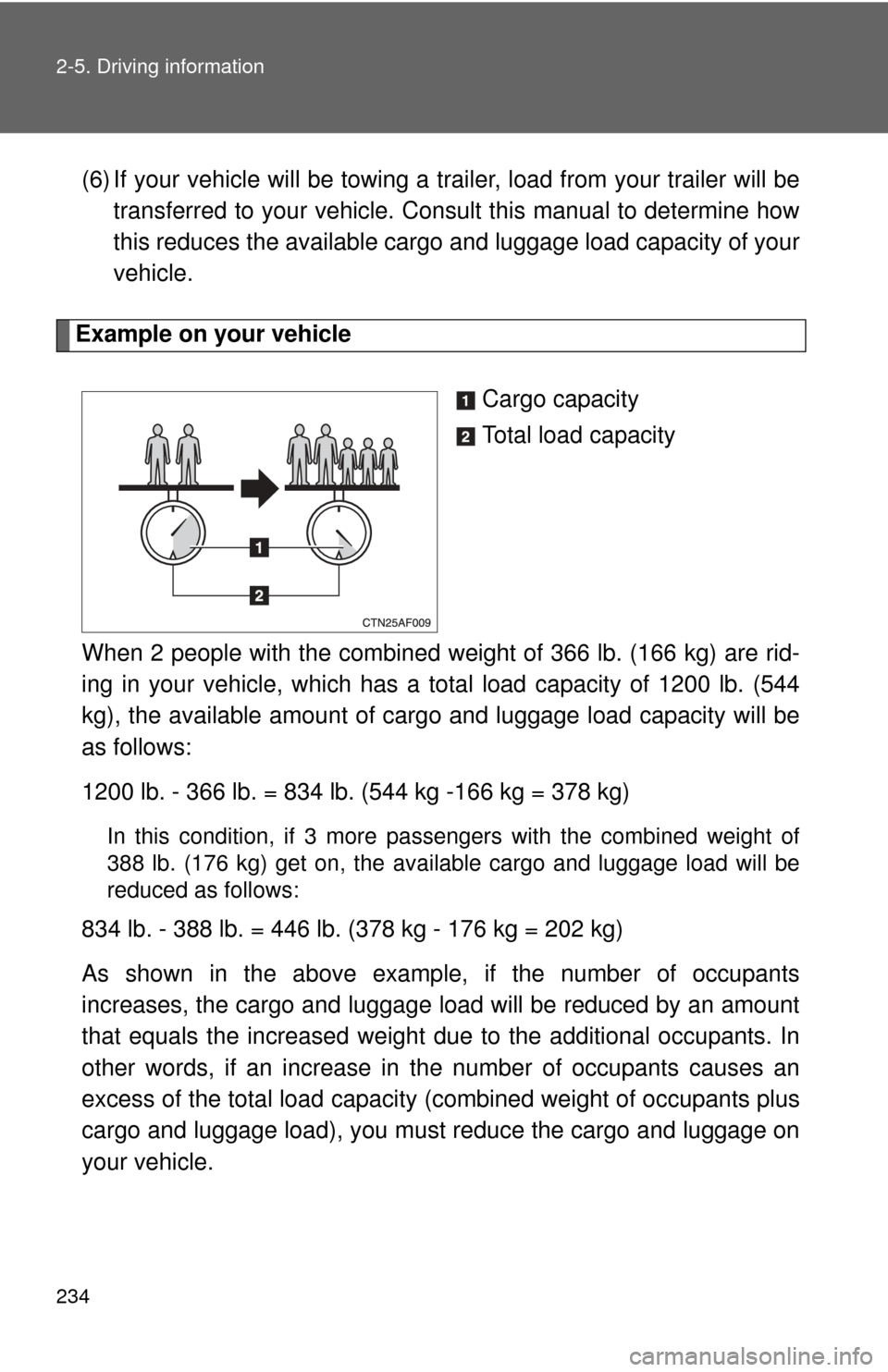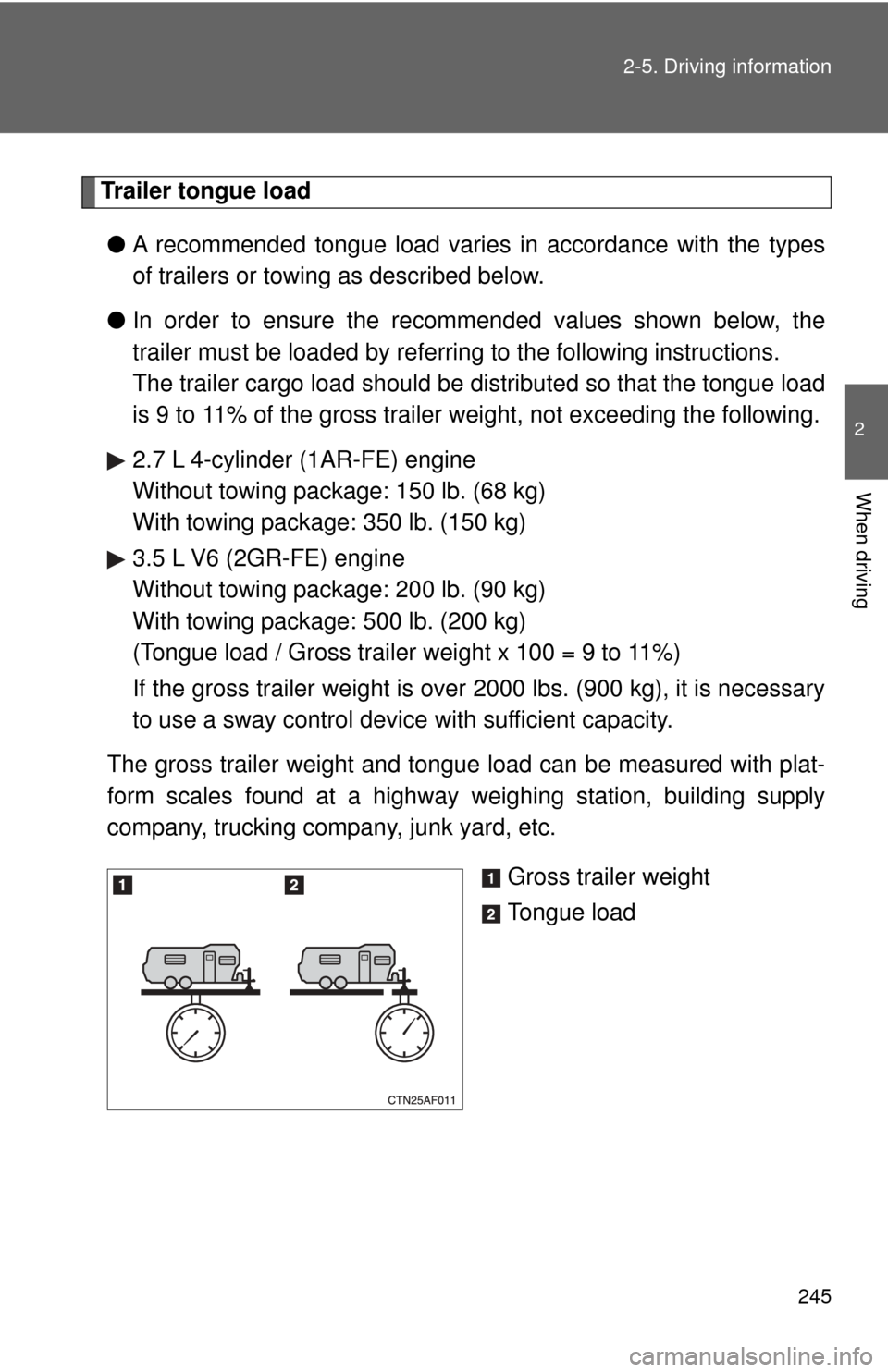Page 234 of 608

234 2-5. Driving information
(6) If your vehicle will be towing a trailer, load from your trailer will be
transferred to your vehicle. Consult this manual to determine how
this reduces the available cargo and luggage load capacity of your
vehicle.
Example on your vehicle
Cargo capacity
Total load capacity
When 2 people with the combined weight of 366 lb. (166 kg) are rid-
ing in your vehicle, which has a total load capacity of 1200 lb. (544
kg), the available amou nt of cargo and luggage load capacity will be
as follows:
1200 lb. - 366 lb. = 834 lb. (544 kg -166 kg = 378 kg)
In this condition, if 3 more pa ssengers with the combined weight of
388 lb. (176 kg) get on , the available cargo and luggage load will be
reduced as follows:
834 lb. - 388 lb. = 446 lb. (378 kg - 176 kg = 202 kg)
As shown in the above example, if the number of occupants
increases, the cargo and luggage load will be reduced by an amount
that equals the increased weight due to the additional occupants. In
other words, if an increase in th e number of occupants causes an
excess of the total load capacity (combined weight of occupants plus
cargo and luggage load), you must reduce the cargo and luggage on
your vehicle.
Page 237 of 608

237
2-5. Driving information
2
When driving
Vehicle load limits
■Total load capacity and seating capacity
These details are also described on the tire and loading information
label. (→P. 463)
CAUTION
■Overloading the vehicle
Do not overload the vehicle.
It may not only cause damage to the ti res, but also degrade steering and
braking ability, resulting in an accident.
Vehicle load limits include total load capacity, seating capacity,
towing capacity and cargo capacity.
■ Total load capacity: 1200 lb. (544 kg)
Total load capacity means the combin ed weight of occupants, cargo
and luggage.
■ Seating capacity: 5 or 7 occupants (Front 2, Rear 3 or 5)
Seating capacity means the maximum number of occupants whose
estimated average weight is 150 lb. (68 kg) per person.
■Towing capacity
2.7 L 4-cylinder (1AR-FE) engine
Without towing package: 1500 lb. (680 kg)
With towing package: 3500 lb. (1500 kg) 3.5 L V6 (2GR-FE) engine
Without towing package: 2000 lb. (900 kg)
With towing package: 5000 lb. (2000 kg)
Towing capacity means the maximu m gross trailer weight (trailer
weight plus its cargo weight) that your vehicle is able to tow.
■ Cargo capacity
Cargo capacity may increase or decrease depending on the weight
and the number of occupants.
Page 243 of 608
243
2-5. Driving information
2
When driving
Weight limits
Confirm that the gross trailer weig ht, gross vehicle weight, gross axle
weight and trailer tongue load are all within the limits.
lb. (kg)
● The gross trailer weight must never exceed towing capacity
described in the table above.
●The gross vehicle weight must
never exceed the GVWR indi-
cated the Certification Label.
● The gross axle weight on each
axle must never exceed the
GAWR indicated the Certifica-
tion Label.
Towing capacity
2.7 L 4-cylinder
(1AR-FE) engine3.5 L V6
(2GR-FE) engine
Without towing package 1500 (680) 2000 (900)
With towing package 3500 (1500) 5000 (2000)
Page 244 of 608

244 2-5. Driving information
Towing related term
Towing related termMeaning
GVWR (Gross Vehicle
Weight Rating) The maximum allowable gross vehicle
weight. The gross vehicle weight is the
total weight of the vehicle. When towing
a trailer, it is the sum of the vehicle
weight (including the occupants, cargo
and any optional equipment installed on
the vehicle) and the tongue load.
GAWR (Gross Axle Weight
Rating) The maximum allowable gross axle
weight. The gross axle weight is the load
placed on each axle (front and rear).
Gross trailer weight The sum of the trailer weight and the
weight of the cargo in the trailer
Towing capacity The maximum allowable gross trailer
weight. Towing capacity is calculated
considering the base vehicle with neces-
sary vehicle equipment and occupants.
Additional optional equipment, passen-
gers and cargo in the vehicle will reduce
the towing capacity, gross trailer weight
include the trailer, cargo and necessary
equipment for towing.
Tongue load The load placed on the trailer hitch ball
Page 245 of 608

245
2-5. Driving information
2
When driving
Trailer tongue load
● A recommended tongue load varies in accordance with the types
of trailers or towing as described below.
● In order to ensure the recommended values shown below, the
trailer must be loaded by referring to the following instructions.
The trailer cargo load should be di stributed so that the tongue load
is 9 to 11% of the gross trailer weight, not exceeding the following.
2.7 L 4-cylinder (1AR-FE) engine
Without towing package: 150 lb. (68 kg)
With towing package: 350 lb. (150 kg)
3.5 L V6 (2GR-FE) engine
Without towing package: 200 lb. (90 kg)
With towing package: 500 lb. (200 kg)
(Tongue load / Gross trailer weight x 100 = 9 to 11%)
If the gross trailer weight is over 2000 lbs. (900 kg), it is necessary
to use a sway control device with sufficient capacity.
The gross trailer weight and tongue l oad can be measured with plat-
form scales found at a highway weighing station, building supply
company, trucking company, junk yard, etc.
Gross trailer weight
Tongue load
Page 250 of 608

250 2-5. Driving information
CAUTION
■Trailer towing precautions
●Follow all the instructions described in this section. Failure to do so could
cause an accident resulting in death or serious injury.
● Exceeding the towing capacity, GVWR or GAWR can cause an accident
resulting in death or serious personal injuries.
■ To avoid accident or injury
●Do not exceed 45 mph (72 km/h) or the posted towing speed limit, which-
ever is lower. As instability (swaying) of the towing vehicle-trailer combina-
tion increases as speed increases, exceeding 45 mph (72 km/h) may
cause loss of control.
● Do not exceed the trailer hitch assembly weight, gross vehicle weight,
gross axle weight and trailer tongue load capacities.
● Never load more weight in the back than in the front of the trailer. About
60% of the load should be in the front half of the trailer, and the remaining
40% in the rear.
● Do not use cruise control when you are towing.
● Slow down and downshift before descending steep or long downhill
grades. Do not make sudden downshifts.
● Avoid holding the brake pedal down too long or applying the brakes too
frequently. This could cause the brakes to overheat and result in reduced
braking efficiency.
● Do not tow the vehicle with the compact spare tire installed.
■ Hitches
●If you wish to install a trailer hitch, contact your Toyota dealer.
● Use only a hitch that conforms to the gross trailer weight requirement.
● 2.7 L 4-cylinder (1AR-FE) engine: The towing capacity of 3500 lb. (1500
kg) can only be guaranteed when using a genuine Toyota hitch assembly
or equivalent.
● 3.5 L V6 (2GR-FE) engine: The towing capacity of 5000 lb. (2000 kg) can
only be guaranteed when using a genuine Toyota hitch assembly or equiv-
alent.
● Follow the directions supplied by the hitch manufacturer.
Page 552 of 608
552
6-1. Specifications
Maintenance data (fuel, oil level, etc.)
Dimensions and weights
*1: GVM condition
*2: Without towing package
*3: With towing package
Overall length188.4 in. (4785 mm)
Overall width75.2 in. (1910 mm)
Overall height Without roof rails
68.1 in. (1730 mm)
With roof rails
69.3 in. (1760 mm)
Wheelbase
109.8 in. (2790 mm)
Front tread 64.0 in. (1625 mm)
64.2 in. (1630 mm)*1
Rear tread
2WD models64.2 in. (1630 mm)
64.8 in. (1645 mm)*1
4WD models64.0 in. (1625 mm)
64.6 in. (1640 mm)*1
Vehicle capacity weight
(Occupant + luggage) 1200 lb. (544 kg)
Towing
capacity
(Trailer
weight +
cargo)2.7 L 4-cylin-
der (1AR-FE)
engine1500 lb. (680 kg)*2
3500 lb. (1500 kg)*3
3.5 L V6
(2GR-FE)
engine2000 lb. (900 kg)*2
5000 lb. (2000 kg)*3
Page 558 of 608

558 6-1. Specifications
Oil viscosity
●The 5W portion of the oil viscosity rating indicates the characteristic
of the oil which allows cold startabi lity. Oils with a lower value before
the W allow for easier starting of the engine in cold weather.
● The 30 in 5W-30 indicates the oil visc osity when the oil is at its oper-
ating temperature. An oil with a hi gher viscosity may be better suited
if the vehicle is operated at high speeds, or under extreme load con-
ditions.
Cooling system
*: With towing package
Capacity
(Reference)
2.7 L 4-cylin-
der (1AR-FE)
engine Without rear air conditioning system
7.3 qt. (6.9 L, 6.1 Imp. qt.)
8.0 qt. (7.6 L, 6.7 Imp. qt.)*
With rear air conditioning system
9.6 qt. (9.1 L, 8.0 Imp. qt.)
10.4 qt. (9.8 L, 8.6 Imp. qt.)*
3.5 L V6
(2GR-FE)
engine Without rear air conditioning system
9.3 qt. (8.8 L, 7.7 Imp. qt.)
10.0 qt. (9.5 L, 8.4 Imp. qt.)*
With rear air conditioning system
11.6 qt. (11.0 L, 9.7 Imp. qt.)
12.4 qt. (11.7 L, 10.3 Imp. qt.)*
Coolant type Use either of the following.
• “Toyota Super Long Life Coolant”
• Similar high-quality ethylene glycol-based non-silicate, non-amine, non-nitrite, and
non-borate coolant with long-life hybrid
organic acid technology
Do not use plain water alone.